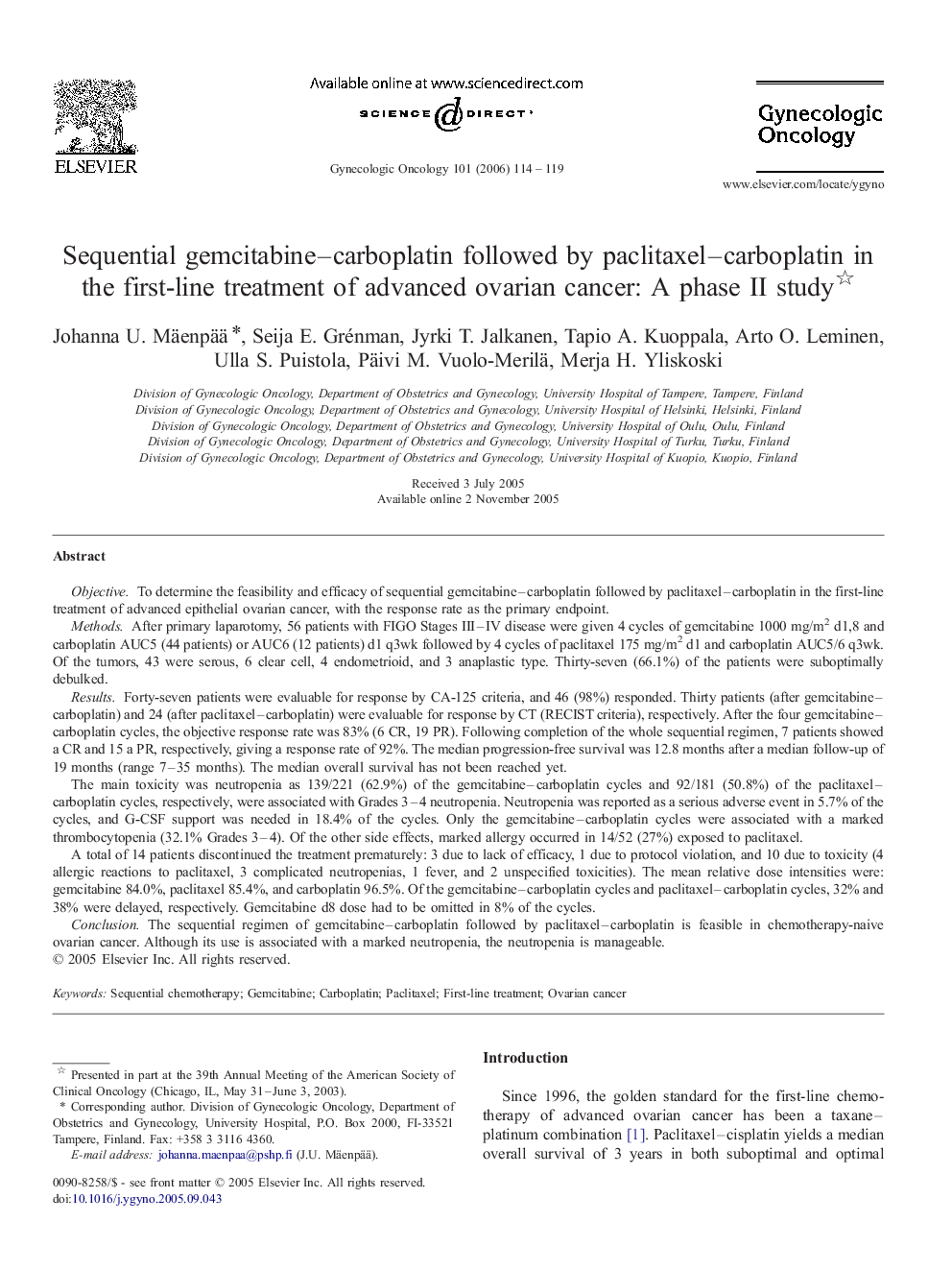| کد مقاله | کد نشریه | سال انتشار | مقاله انگلیسی | نسخه تمام متن |
|---|---|---|---|---|
| 3945213 | 1254254 | 2006 | 6 صفحه PDF | دانلود رایگان |

Objective.To determine the feasibility and efficacy of sequential gemcitabine–carboplatin followed by paclitaxel–carboplatin in the first-line treatment of advanced epithelial ovarian cancer, with the response rate as the primary endpoint.Methods.After primary laparotomy, 56 patients with FIGO Stages III–IV disease were given 4 cycles of gemcitabine 1000 mg/m2 d1,8 and carboplatin AUC5 (44 patients) or AUC6 (12 patients) d1 q3wk followed by 4 cycles of paclitaxel 175 mg/m2 d1 and carboplatin AUC5/6 q3wk. Of the tumors, 43 were serous, 6 clear cell, 4 endometrioid, and 3 anaplastic type. Thirty-seven (66.1%) of the patients were suboptimally debulked.Results.Forty-seven patients were evaluable for response by CA-125 criteria, and 46 (98%) responded. Thirty patients (after gemcitabine–carboplatin) and 24 (after paclitaxel–carboplatin) were evaluable for response by CT (RECIST criteria), respectively. After the four gemcitabine–carboplatin cycles, the objective response rate was 83% (6 CR, 19 PR). Following completion of the whole sequential regimen, 7 patients showed a CR and 15 a PR, respectively, giving a response rate of 92%. The median progression-free survival was 12.8 months after a median follow-up of 19 months (range 7–35 months). The median overall survival has not been reached yet.The main toxicity was neutropenia as 139/221 (62.9%) of the gemcitabine–carboplatin cycles and 92/181 (50.8%) of the paclitaxel–carboplatin cycles, respectively, were associated with Grades 3–4 neutropenia. Neutropenia was reported as a serious adverse event in 5.7% of the cycles, and G-CSF support was needed in 18.4% of the cycles. Only the gemcitabine–carboplatin cycles were associated with a marked thrombocytopenia (32.1% Grades 3–4). Of the other side effects, marked allergy occurred in 14/52 (27%) exposed to paclitaxel.A total of 14 patients discontinued the treatment prematurely: 3 due to lack of efficacy, 1 due to protocol violation, and 10 due to toxicity (4 allergic reactions to paclitaxel, 3 complicated neutropenias, 1 fever, and 2 unspecified toxicities). The mean relative dose intensities were: gemcitabine 84.0%, paclitaxel 85.4%, and carboplatin 96.5%. Of the gemcitabine–carboplatin cycles and paclitaxel–carboplatin cycles, 32% and 38% were delayed, respectively. Gemcitabine d8 dose had to be omitted in 8% of the cycles.Conclusion.The sequential regimen of gemcitabine–carboplatin followed by paclitaxel–carboplatin is feasible in chemotherapy-naive ovarian cancer. Although its use is associated with a marked neutropenia, the neutropenia is manageable.
Journal: Gynecologic Oncology - Volume 101, Issue 1, April 2006, Pages 114–119